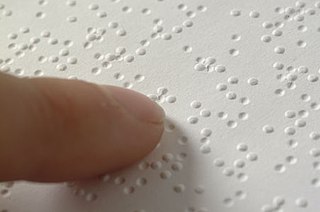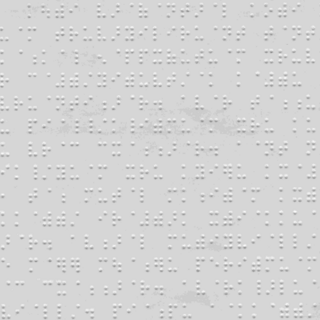
Braille is a tactile writing system used by people who are visually impaired. It is traditionally written with embossed paper. Braille users can read computer screens and other electronic supports using refreshable braille displays. They can write braille with the original slate and stylus or type it on a braille writer, such as a portable braille notetaker or computer that prints with a braille embosser.
A diacritic is a glyph added to a letter or basic glyph. The term derives from the Ancient Greek διακριτικός, from διακρίνω. The word diacritic is primarily a noun, though it is sometimes used as an adjective, whereas diacritical is only an adjective. Some diacritics, such as the acute ( ´ ) and grave ( ` ), are often called accents. Diacritics may appear above or below a letter or in some other position such as within the letter or between two letters.
The Danish and Norwegian alphabet, called the Dano-Norwegian alphabet, is based on the Latin alphabet and has consisted of the following 29 letters since 1917 (Norwegian) and 1948 (Danish):

Á, á (a-acute) is a letter of the Chinese (Pinyin), Blackfoot, Czech, Dutch, Faroese, Galician, Hungarian, Icelandic, Irish, Kazakh, Lakota, Navajo, Occitan, Portuguese, Sámi, Slovak, Spanish, Vietnamese, Welsh, and Western Apache languages as a variant of the letter a. It is sometimes confused with à; e.g. "5 pommes á $1", which is more commonly written as "5 pommes à $1".

Hebrew Braille is the braille alphabet for Hebrew. The International Hebrew Braille Code is widely used. It was devised in the 1930s and completed in 1944. It is based on international norms, with additional letters devised to accommodate differences between English Braille and the Hebrew alphabet. Unlike Hebrew, but in keeping with other braille alphabets, Hebrew Braille is read from left to right instead of right to left., and unlike English Braille, it is an Abjad, all consonants.

Bharati braille, or Bharatiya Braille, is a largely unified braille script for writing the languages of India. When India gained independence, eleven braille scripts were in use, in different parts of the country and for different languages. By 1951, a single national standard had been settled on, Bharati braille, which has since been adopted by Sri Lanka, Nepal, and Bangladesh. There are slight differences in the orthographies for Nepali in India and Nepal, and for Tamil in India and Sri Lanka. There are significant differences in Bengali Braille between India and Bangladesh, with several letters differing. Pakistan has not adopted Bharati braille, so the Urdu Braille of Pakistan is an entirely different alphabet than the Urdu Braille of India, with their commonalities largely due to their common inheritance from English or International Braille. Sinhala Braille largely conforms to other Bharati, but differs significantly toward the end of the alphabet, and is covered in its own article.
Greek Braille is the braille alphabet of the Greek language. It is based on international braille conventions, generally corresponding to Latin transliteration. In Greek, it is known as Κώδικας Μπράιγ Kôdikas Mpraig "Braille Code".

The Esperanto language has a dedicated braille alphabet. One Esperanto braille magazine, Aŭroro, has been published since 1920, and another, Esperanta Ligilo, since 1904.
The goal of braille uniformity is to unify the braille alphabets of the world as much as possible, so that literacy in one braille alphabet readily transfers to another. Unification was first achieved by a convention of the International Congress on Work for the Blind in 1878, where it was decided to replace the mutually incompatible national conventions of the time with the French values of the basic Latin alphabet, both for languages that use Latin-based alphabets and, through their Latin equivalents, for languages that use other scripts. However, the unification did not address letters beyond these 26, leaving French and German Braille partially incompatible and as braille spread to new languages with new needs, national conventions again became disparate. A second round of unification was undertaken under the auspices of UNESCO in 1951, setting the foundation for international braille usage today.
Danish orthography is the system used to write the Danish language. The oldest preserved examples of written Danish are in the Runic alphabet, but by the end of the High Middle Ages the Runes had mostly been replaced by the Latin letters.

The braille alphabet used to write Hungarian is based on the international norm for the 26 basic letters of the Latin script. However, the letters for q and z have been replaced, to increase the symmetry of the accented letters of the Hungarian alphabet, which are largely innovative to Hungarian braille.

French Braille is the original braille alphabet, and the basis of all others. The alphabetic order of French has become the basis of the international braille convention, used by most braille alphabets around the world. However, only the 25 basic letters of the French alphabet plus w have become internationalized; the additional letters are largely restricted to French Braille and the alphabets of some neighboring European countries.
Luxembourgish Braille is the braille alphabet of the Luxembourgish language. It is very close to French Braille, but uses eight-dot cells, with the extra pair of dots at the bottom of each cell to indicate capitalization and accent marks. It is the only eight-dot alphabet listed in Unesco (2013). Children start off with the older six-dot script, then switch to eight-dot cells when they start primary school and learn the numbers.
Scandinavian Braille is a braille alphabet used, with differences in orthography and punctuation, for the languages of the mainland Nordic countries: Danish, Norwegian, Swedish, and Finnish. In a generally reduced form it is used for Greenlandic.
Portuguese Braille is the braille alphabet of the Portuguese language, both in Portugal and in Brazil. It is very close to French Braille, with slight modification of the accented letters and some differences in punctuation.
Turkish Braille is the braille alphabet of the Turkish language.
Irish Braille is the braille alphabet of the Irish language. It is augmented by specifically Irish letters for vowels that take acute accents in print:
IPA Braille is the modern standard Braille encoding of the International Phonetic Alphabet (IPA), as recognized by the International Council on English Braille.

Spanish Braille is the braille alphabet of Spanish and Galician. It is very close to French Braille, with the addition of a letter for ñ, slight modification of the accented letters and some differences in punctuation. Further conventions have been unified by the Latin American Blind Union, but differences with Spain remain.
Cambodian or Khmer Braille is the braille alphabet of the Khmer language of Cambodia.







